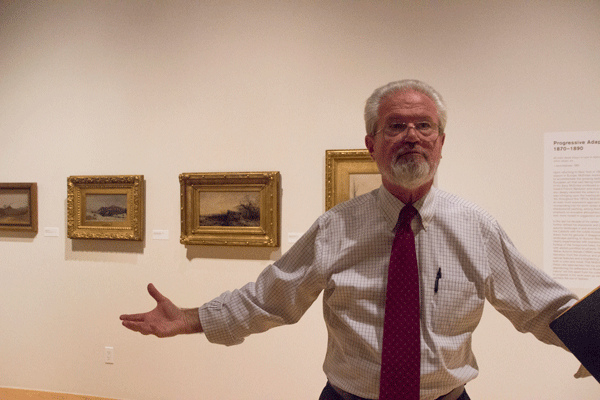
The beauty of autumn in New Paltz may as well be a natural gallery born from the intense hues of orange, red and green which paint the town, village and campus.
The SUNY New Paltz campus is externally artful and colorful in autumn. However,w from Aug. 26 to Dec. 3., the Samuel Dorsky Museum of Art will be providing the beauty of autumn in at least one building on campus with the work of Jervis McEntee, a 19th century painter-poet of the Hudson River School.
McEntee worked alongside fellow Hudson River School painters amid his 40-year career. Of which included Asher B. Durand, Frederic Edwin Church, John Frederick Kensett and Sanford Robinson Gifford. McEntee’s work often would demonstrate artistic responses to the era in which he lived. Landscape pieces echoed the anguish of Civil War battles with images of injured trees and brush. Fall was a infatuation of McEntee’s; he displayed his passion of the Hudson Valley area in late fall in the majority of his works.
On Oct. 3 at 2 p.m., Kevin J. Avery, a senior scholar at The Metropolitan Museum of Art and adjunct professor at Hunter College led a tour around the gallery in the Dorsky where McEntee’s work adorned the walls.
“He was a very divided man,” Avery said. “He was married to the institution, yet resented the church for the public nature of his enterprise.”
Early works of McEntee such as “Melancholy Days” capture the beginning cultivation of his artistic identity. Contrary to popular belief, McEntee did not view autumn as gloomy and dismal; he saw the season as contemplative and peaceful—a time of introspective transition into a new chapter. The work “Melancholy Days” itself is a dichotomy between the gnarled branches and brokenness of an abandoned battle field and the placid sunset in the background. He was a divided man, as Avery said, and showed clearly in his work.
“I find his work fascinating,” Avery said. “McEntee will really apply himself to a painting. There is a certain flux and entropy that about his work that I find fascinating and puzzling.”
In McEntree’s later works, more figures appear in his work. Although the main focus of any given piece of his was the landscape, he began adding people residing in the environment. The faces of these figures were often indiscernible, but their mood could only be deciphered through the connotation of the landscape itself. According to Avery, during that time period—late 1800s—paintings which included figures sold more.
In addition to landscape pieces capturing the elegant essence of fall, McEntee was also enamored with winter. Avery described his winter pieces as depressive evocations. “Winter in the Country,” like many of McEntee’s paintings, is accompanied by a poem by the painter himself.
“Perhaps what would mark my work among that of my brother artists is a preference for the soberer phases of Nature, the gray days of November and its leafless trees as well as the Winter landscape,” McEntee wrote.
The words of this poem display McEntee’s reverence for the seasons; they may induce a certain emotion that can only be expressed through art. Fall and winter—seasons of pensive and somber thought—shine as exquisite works of nature through the eyes of McEntee, and the eyes of those who may catch a glimpse of his brilliance.
